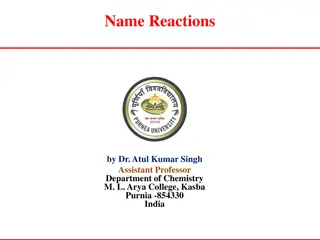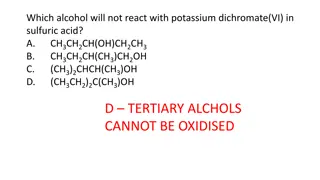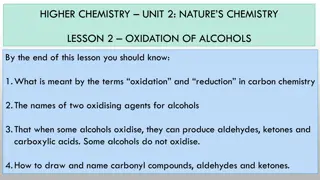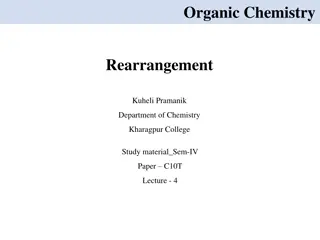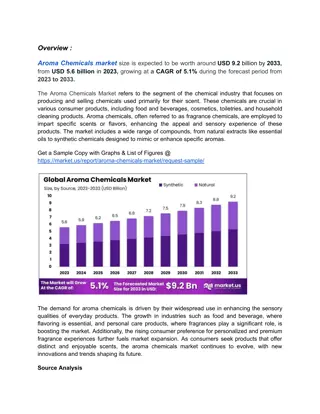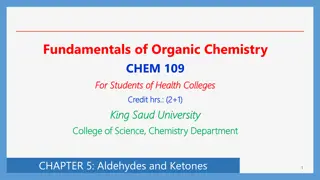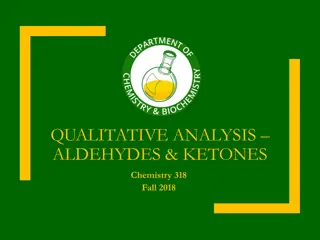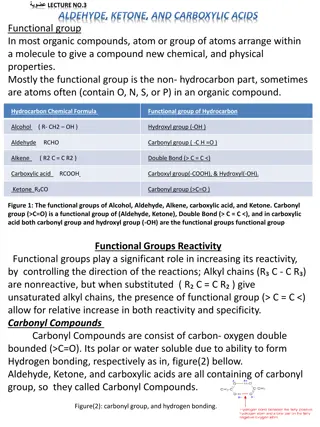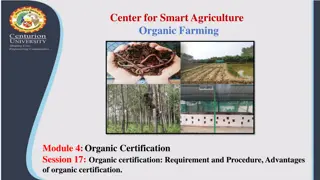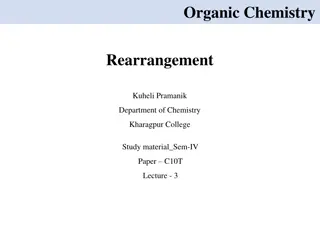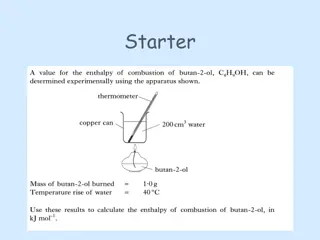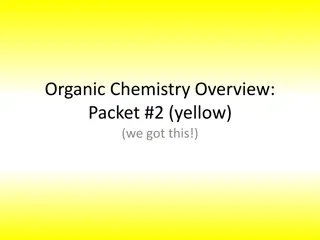Understanding Aldehydes and Ketones in Organic Chemistry
Aldehydes and ketones are compounds that contain carbonyl groups (>C=O). Aldehydes have the CO group linked to either two hydrogen atoms or one hydrogen atom and one alkyl or aryl group, while ketones have the CO group linked to two alkyl or aryl groups. The structure of the carbonyl group is characterized by sp2 hybridization of both carbon and oxygen atoms. The acidity of the hydrogen atoms in aldehydes and ketones allows for proton release due to stabilization by resonance. Reactions such as the Wittig reaction, Perkins reaction, and Benzoin condensation play significant roles in organic synthesis involving aldehydes and ketones.
Download Presentation

Please find below an Image/Link to download the presentation.
The content on the website is provided AS IS for your information and personal use only. It may not be sold, licensed, or shared on other websites without obtaining consent from the author. Download presentation by click this link. If you encounter any issues during the download, it is possible that the publisher has removed the file from their server.
E N D
Presentation Transcript
ALDEHYDE AND KETONES Sixth Semester Organic Chemistry II Dr.S Sreelatha Department of Chemistry NSS Colllege Pandalam
Aldehydes and ketones are compound containing carbonyl groups (>C=O) In aldehyde the CO group is linked either to two H atoms or to one H atom and one alkyl or aryl group. In ketones CO group is linked to two alkyl or aryl group. General formula of aldehyde : R-CHO General formula of ketones : R-CO-R
Structure of Carbonyl group Both carbon and oxygen in CO group are sp2hybridized. The carbon atom forms three bond at 120o to each other. The double bond between carbon and oxygen contain a and a bond The electron cloud is displaced towards the oxygen atom. This causes polarisation in the carbonyl group (2.3-2.8 D)
Acidity of - Hydrogens -Hydrogen of aldehyde and ketones are acidic.ie, they can be released as a protons. This acidity is due to the fact that anion formed by the release of the - Hydrogen as a proton is stabilized by resonance.
Witting reaction The Wittig reaction is a chemical reaction of an aldehyde or ketone with a triphenyl phosphonium ylide to give an alkene and triphenylphosphine oxide.
Mechanism Step 1: The nucleophilic C of the ylid Wittig reagent adds to the electrophilic C in the polar carbonyl group, electrons from the C=O bond are used to form a bond to the +ve P atom. This creates a cyclic intermeiate called an oxaphosphetane. Step 2: Decomposition of the intermediate by breaking the C-Pand C-O bonds leads to the formation of the C=C bond of the alkene and triphenyl phosphine oxide. +
Perkins reactions The Perkin reaction is an organic reaction that is used to make cinnamic acids. It gives an , -unsaturated aromatic acid in the presence of an alkali salt of the acid.
Mechanism In the first step, the cyanide ion reacts with benzaldehyde to form cyanohydrin. Condensation reaction takes place between the cyanohydrin and benzaldehyde. Rearrangement takes place and the removal of cyanide ion results in the formation of Benzoin.
Knoevenagel reaction The Knoevenagel reaction is a variant of the aldol condensation historically performed with malonic acid (or malonate ethyl), although it can theoretically be performed with any 1 - 3 dicarbonyl compound ( - dicarbonyl) C6H5CHO + CH2(COOC2H5)2 C6H5CH=C(COOC2H5)2 C6H5-CH=CH-COOH
Mannich reaction The Mannich reaction is an organic reaction which consists of an amino alkylation of an acidic proton placed next to a carbonylfunctional group by formaldehyde and a primary or secondary amine or ammonia. The final product is a -amino-carbonyl compound.
Cannizzaros reaction The Cannizzaro reaction, named after its discoverer Stanislao Cannizzaro, is a chemical reaction that involves the base-induced disproportionation of two molecules of a non-enolizable aldehyde to give a primary alcohol and a carboxylic acid. 2 HCHO + NaOH CH3OH + HCOONa 2 C6H5CHO + KOH C6H5CH2OH + C6H5COOK
The Baeyer- Villinger oxidation The Baeyer Villiger oxidation is an organic reaction that forms an ester from a ketone or a lactone from a cyclic ketone, using peroxyacids or peroxides as the oxidant
Clemmenson reduction Clemmensen reduction is a chemical reaction described as a reduction of ketones (or aldehydes) to alkanes using zinc amalgam and concentrated hydrochloric acid.
Wolf-Kishner reduction The reduction of aldehydes and ketones to alkanes. Condensation of the carbonyl compound with hydrazine forms the hydrazone, and treatment with base induces the reduction of the carbon coupled with oxidation of the hydrazine to gaseous nitrogen, to yield the corresponding alkane.
Reduction with LiAlH4/NaBH4 Aldehydes and ketones are most readily reduced with hydride reagents The reducing agents LiAlH4and NaBH4act as a source of 4 x H-(hydride ion) Overall 2 H atoms are added across the C=O to give H-C-O-H Hydride reacts with the carbonyl group, C=O, in aldehydes or ketones to give alcohols. The substituents on the carbonyl dictate the nature of the product alcohol. Reduction of methanal (formaldehyde) gives methanol. Reduction of other aldehydes gives primary alcohols. Reduction of ketones gives secondary alcohols. The acidic work-up converts an intermediate metal alkoxide salt into the desired alcohol via a simple acid base reaction
Mechanism Step 1: The nucleophilic H in the hydride reagent adds to the electrophilic C in the polar carbonyl group in the aldehyde, electrons from the C=O move to the O creating an intermediate metal alkoxide complex. Step 2: This is the work-up step, a simple acid/base reaction. Protonation of the alkoxide oxygen creates the primary alcohol product from the intermediate complex.
Meerwein-Ponndorf-Verley Reduction The Meerwein Ponndorf Verley (MPV) reduction in organic chemistry is the reduction of ketones and aldehydes to their corresponding alcohols utilizing aluminium alkoxide catalysis in the presence of a sacrificial alcohol.
Action of Grignad reagent Grignard reagents react with the carbonyl group, C=O, in aldehydes or ketones to give alcohols. The substituents on the carbonyl dictate the nature of the product alcohol. Addition to methanal (formaldehyde) gives primary alcohols. Addition to other aldehydes gives secondary alcohols. Addition to ketones gives tertiary alcohols. The acidic work-up converts an intermediate metal alkoxide salt into the desired alcohol via a simple acid base reaction.
Mechanism Step 1: The nucleophilic C in the organometallic reagent adds to the electrophilic C in the polar carbonyl group, electrons from the C=O move to the electronegative O creating an intermediate metal alkoxide complex. Step 2: This is the work-up step, a simple acid / base reaction. Protonation of the alkoxide oxygen creates the alcohol product from the intermediate complex.
Reimer-Tiemann Reaction The Reimer Tiemann reaction is a chemical reaction used for the ortho- formylation of phenols; with the simplest example being the conversion of phenol to salicylaldehyde.
Beckmann Rearrangement The acid-catalyzed conversion of an oxime into an amide is known as Beckmann rearrangement
Thank You Dr S. Sreelatha, Department of Chemistry




